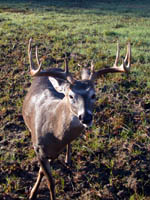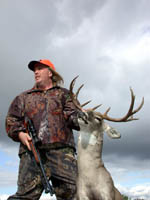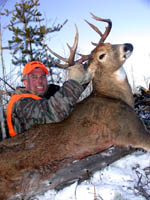
|
Features
|
|
|
|
Books
|
|
|
|
Fun & Games
|
|
|
|
Contact Us
|
|
|
John's Journal... Entry 223, Day 1
THE FEAR FACTOR: HOW MUCH HUNTING PRESSURE CAN A BUCK STAND?
Fear of Dogs Moves Deer
 “You
boys yell and holler and jump into those thick places,” Adrian Hitt,
the hunt master on the Tombigbee Hunting club, instructed the drivers.
“But when you come to a downed tree or an isolated briar thicket,
stop walking and hollering when you’re within gun range of the thicket.
If a big buck is in that thick spot, after about a minute, he’ll
come blowing out of the cover. As long as the buck can hear you and knows
where you are, he’ll remain in that thicket and won’t come
out until after you’ve passed by. But when you hush, and the buck
isn’t positive about where you are, he’ll become nervous and
scared. Then his nerves will force him to jump up and come out of the
thicket where you can take a shot at him.”
“You
boys yell and holler and jump into those thick places,” Adrian Hitt,
the hunt master on the Tombigbee Hunting club, instructed the drivers.
“But when you come to a downed tree or an isolated briar thicket,
stop walking and hollering when you’re within gun range of the thicket.
If a big buck is in that thick spot, after about a minute, he’ll
come blowing out of the cover. As long as the buck can hear you and knows
where you are, he’ll remain in that thicket and won’t come
out until after you’ve passed by. But when you hush, and the buck
isn’t positive about where you are, he’ll become nervous and
scared. Then his nerves will force him to jump up and come out of the
thicket where you can take a shot at him.”
 About
10:00 in the morning, I found an isolated briar thicket. Off to the right,
I heard my brother, Archie, singing out, “Hootie, Hootie, Hootie,
Hootie.” To the left, I heard the driving sounds of, “Yodee,
Yodee, Yodee,” of my nephew, Bubba. When I was within about 30 yards
of the thicket, I held my Remington 12 gauge, three-inch magnum at the
ready and stood dead still. I waited for what seemed an eternity. As I
listened to the other drivers, I still heard Hitt’s instructions
ringing in my ears, “If a buck’s in a thicket, he’s
got to go – if you stop. Wait a minute or two, and he’ll come
out.”
About
10:00 in the morning, I found an isolated briar thicket. Off to the right,
I heard my brother, Archie, singing out, “Hootie, Hootie, Hootie,
Hootie.” To the left, I heard the driving sounds of, “Yodee,
Yodee, Yodee,” of my nephew, Bubba. When I was within about 30 yards
of the thicket, I held my Remington 12 gauge, three-inch magnum at the
ready and stood dead still. I waited for what seemed an eternity. As I
listened to the other drivers, I still heard Hitt’s instructions
ringing in my ears, “If a buck’s in a thicket, he’s
got to go – if you stop. Wait a minute or two, and he’ll come
out.”
 As
a driver, I’d gone into thick cover through the years to spook the
deer out. But I didn’t have much faith in this new tactic of waiting
silently. However, I knew Adrian Hitt was a master deer hunter who consistently
bagged more bucks than any other drivers on the Tombigbee Hunting Club.
So I waited. I felt foolish, but I waited. If no deer was in that briar
thicket, I had wasted my time. Just as I made the decision to begin to
yell and start to walk again, the briars came alive with antlers and hooves.
The buck dove straight away from me to get out of the briars. At the same
time, my shotgun with No. 1 buckshot found its comfortable resting place
in the hollow of my shoulder. As the buck came up again for his second
jump out of the thicket, the bead on the barrel found the groove between
the deer’s two shoulder blades where the neck joined the body. When
my gun reported, the buck went down. As I walked over to the fat 6 point
to admire my trophy, I wondered…
As
a driver, I’d gone into thick cover through the years to spook the
deer out. But I didn’t have much faith in this new tactic of waiting
silently. However, I knew Adrian Hitt was a master deer hunter who consistently
bagged more bucks than any other drivers on the Tombigbee Hunting Club.
So I waited. I felt foolish, but I waited. If no deer was in that briar
thicket, I had wasted my time. Just as I made the decision to begin to
yell and start to walk again, the briars came alive with antlers and hooves.
The buck dove straight away from me to get out of the briars. At the same
time, my shotgun with No. 1 buckshot found its comfortable resting place
in the hollow of my shoulder. As the buck came up again for his second
jump out of the thicket, the bead on the barrel found the groove between
the deer’s two shoulder blades where the neck joined the body. When
my gun reported, the buck went down. As I walked over to the fat 6 point
to admire my trophy, I wondered…
* how I had used the fear factor to take the buck,
* what caused deer to fear man,
* how much hunting pressure could deer stand and
* how many human encounters could a deer that lived on 2000 acres have
with humans before he started avoiding an area.
Because I realized my learning more about how and why a deer reacted to hunting pressure would help me bag bucks more effectively, I talked with master deer hunters and scientists to learn the answers.
TOMORROW: HOW DEER LEARN TO FEAR MAN
Check back each day this week for more about THE FEAR FACTOR: HOW MUCH HUNTING PRESSURE CAN A BUCK STAND?...
Day 1 - Fear of Dogs Moves
Deer
Day 2 - How Deer Learn To Fear Man
Day 3 - Amount Of Human Contact A Buck Can
Stand Before Reducing Movement And Nocturnal Deer
Day 4 - What Hunters Can Do To Reduce Pressure
And Increase Deer Sightings And Hunting These Pressured Bucks
Day 5 - Prevent A Buck From Seeing, Smelling
or Hearing You, Thereby Decreasing Hunter Pressure